Imagine how difficult it is now.
The Monemvasia Winery Tsimbidi in the Peloponnese region of Greece has seen sales drop by almost 90%.
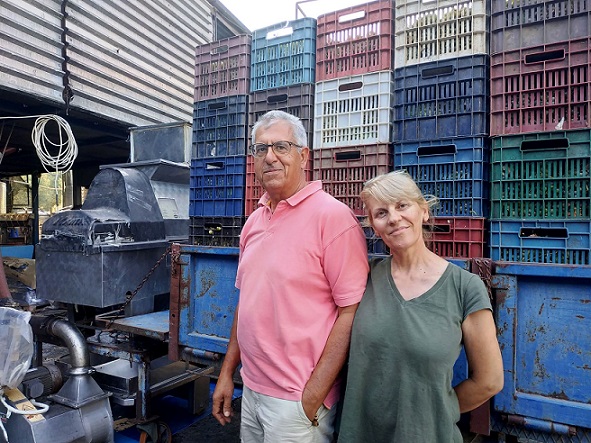
Yorgos Tsimbidis and wife Elli (above), who founded the winery in 1997, were about to open a new winery and tasting rooms (below), after years of working in a “garage”. They are also preparing for the launch of the third vintage of their historic wine, Monemvasia-Malvasia, after 10 years of ageing.
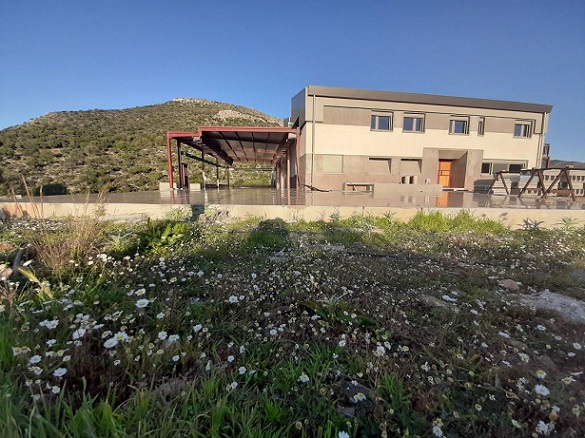
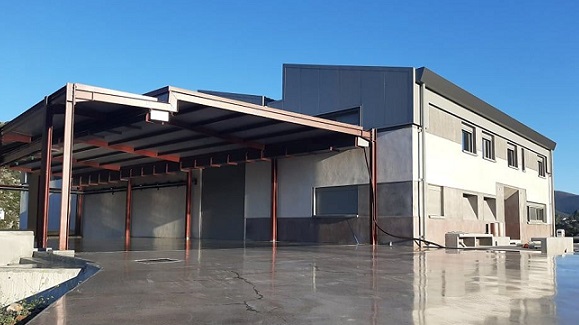
Elli told Canopy: “At this particularly tough time of quarantine we are facing a huge decline in sales both in Greece and abroad.
“Unfortunately, the sales have dropped almost 90%. We have sent most of our employees home – we haven't fired anyone – and maintain a very simple delivery service in Greece. We also try to continue our digital marketing and we are still able to prepare orders with a minimum number of staff.
“We hope to see an improvement in the summer months but, mostly, we hope that as many people as possible remain safe from the virus.”
Before the current crisis caused by the Covid-19 pandemic, they were “pleased with the increasing recognition of Monemvasia-Malvasia slowly taking place in Greece and abroad”.
As for the new winery, Elli says: “For years our priority has been the vineyards. Our old winery is a total ‘garage winery’, only a working space. The new winery is just now almost finished. It would be open for visitors this summer but with the measures taken for the pandemic we do not really know how things will evolve.”
It’s such a shame – they have worked so hard to revitalize the wine which was famous for five centuries…
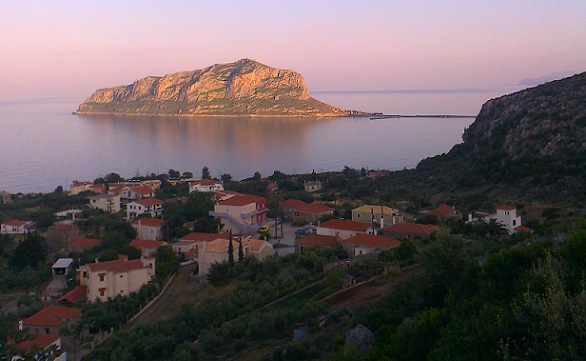
The most famous wine in the Middle Ages
Merchants from the medieval rock-fortress of Monemvasia (above) traded the wine under the name of ‘Monemvasio’, ‘Monemvasioti’ or ‘Monemvasia’, and the Venetian and Genoese traders sold it under the name ‘Malvasia’.French traders sold it as Malvoisie and in England it was known as Malmsey.
'You shall have wine enough, my lord, anon'William Shakespeare mentions the wine in his plays Love’s Labours Lost, Henry IV Part 2, and King Richard III – where the Duke of Clarence is drowned in a “malmsey-butt”.
Prior to this, the Duke of Clarence innocently asks for a cup of wine, and one of his jailers responds: “You shall have wine enough, my lord, anon”.
The domination of the Greek ‘Monemvasia-Malvasia’ lasted from the 12th century in the Byzantine city of Monemvasia and continued in Crete under Venetian rule until the middle of the 17th century.
Its heyday ended with the Turkish occupation of Monemvasia, which resulted in the destruction of all vineyards on the peninsula.
However, in Europe, the name continued to be used for various non-related grape varieties and Malmsey became associated with wines from Madeira.
The revival begins
Monemvasia Winery was founded on September 20, 1997, in the village of Vellies, close to Monemavsia, “with the dream of recreating the historic Malvasia wine in its birthplace and our hometown, Monemvasia,” explains Elli.“The first step to the whole effort was to find the local varieties of our area that were the most probable to have been used in the production of Malvasia originally. Also which of them can give us quality wines in modern-day standards.
“This effort was guided by Dr Stavroula Kourakou-Dragona, a prominent academic who has shaped the landscape of modern Greek wine, the Wine Institute and the Agricultural University of Athens.
“The result of the research was our 30ha vineyards with the local varieties Monemvasia, Kydonitsa, Asproudes and Assyrtiko.”
.jpg)
About 40% of the vineyards contain Kydonitsa, 20% Monemvasia (above), 15% Assyrtiko and 10% Asproudes. The remaining 15% are the red varieties Agiorgitiko and Limniona.
Elli adds: “When Yorgos returned to his village after his studies, he noticed that his beloved birthplace produced only bulk product: mainly olive oil and some mediocre house wines. He really believed in the potential for quality of our area and, inspired by the history of Monemvasia and Malvasia, he started a winery to recreate the Malvasia wine.
“When this finally happened, we felt that we proved that Monemvasia has potential for high-quality products and that it could get on the map as a famous wine-producing region. Our whole family is very invested in the winery, not only as a family business but also as a means to give back to the local community, culturally and socially.”
For 12 years, Yorgos studied the characteristics of local grape varieties, created experimental vineyards, and fought to get Monemvasia-Malvasia wines recognised as a Protected Designation of Origin for sweet white wine and liqueur wine made from sundried grapes. This eventually happened on July 23, 2009.
'This was a very difficult thing to do'Elli says: “This was a very difficult thing to do. We had to prove a historic tie between Monemvasia and Malvasia, also to indicate a varietal composition that made sense, to show that the wine in question had certain organoleptic and chemical properties and a quality that resonates with its fame and derives from the uniqueness of our terroir.”
Winemaking
The first official bottling of the winery’s Malvasia as a PDO Monemvasia-Malvasia was the 2010 vintage. This was released in 2013. The 2012 vintage is also available and the 2011 vintage is due to be released next year after 10 years’ ageing in oak barriques.Annual production is around 300,000 bottles, spread over 17 labels, with the PDO wine Monemvasia-Malvasia at the top.
The winemaking for this flagship wine is “based on traditional methods but with a modern approach,” Elli states.
Monemvasia-Malvasia is a naturally sweet wine produced from sundried grapes of at least 51% Monemvasia and the rest comprises Assyrtiko, Kydonitsa and Asproudes. The grapes are harvested overripe at the same time and then sundried for nearly two weeks to get a condensed must of almost 320g/L of sugars.
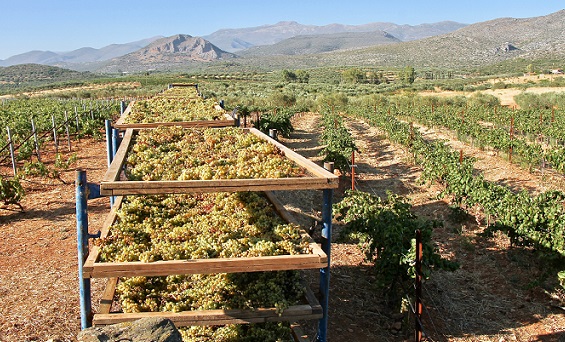
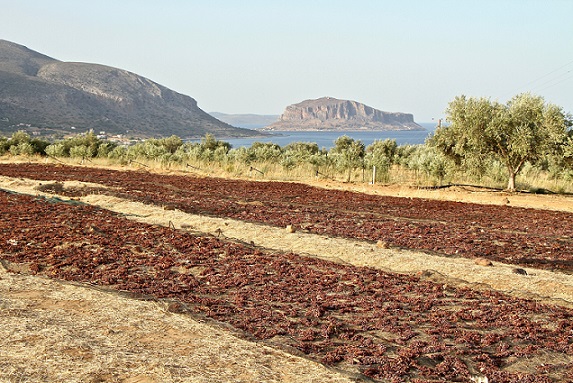
There are two systems in operation for the drying, both in the vineyards (above). Some are dried on nets on top of hay on the ground next to the vines while others are dried on trays with screens on a scaffold-like construction so that the air can circulate. “The sun-drying system we choose mostly depends on the terrain of the vineyard and the weather conditions (possibility of rain),” Elli explains.
She adds: “We have to turn the grapes once or twice on each tray and the trays change places twice during a 12-day period because the upper tray dries more quickly.”
Fermentation is by selected strains of dry active yeast at a temperature of about 20°C. The fermentation naturally stops when the alcohol content is around 13%. The minimum required ageing is 24 months in oak barriques.
“The production method in its main idea has not changed much really,” Elli says. “We just can monitor the process a lot better than in the past, we also inoculate and have modern equipment for the destemming, the pressing, the cooling etc.
“It is a very special product of great sentimental value for us. It showcases the continuity of the history of our region in the production of high-quality wine with our local varieties from our unique terroir, and gives us – and all locals – great pride.”
'It was our life dream'
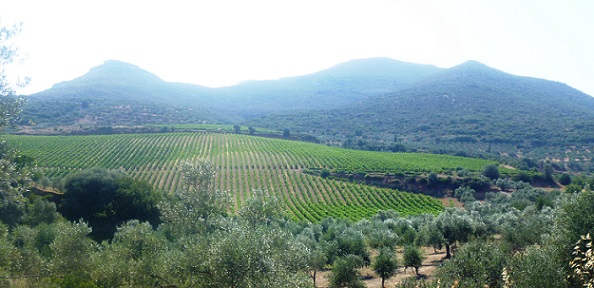
Amazing achievement
Yorgos and Elli are rightly proud of their achievements so far.Elli tells Canopy: “We invested so much in this effort because it was our life dream. We started the winery without knowing anything about wine, Yorgos studied physics at the university and I was a teacher for several years. And now, 23 years later, we have managed not only to create a Malvasia wine but also vineyards with very special local varieties and a range of wines that has made us very proud and has been awarded repeatedly for consecutive years in international wine competitions. Thus, we have created a very important legacy for our daughters Marialena and Anastasia, who will continue the business, and for our local community, as a positive example of what our region is capable of.”

 English
English French
French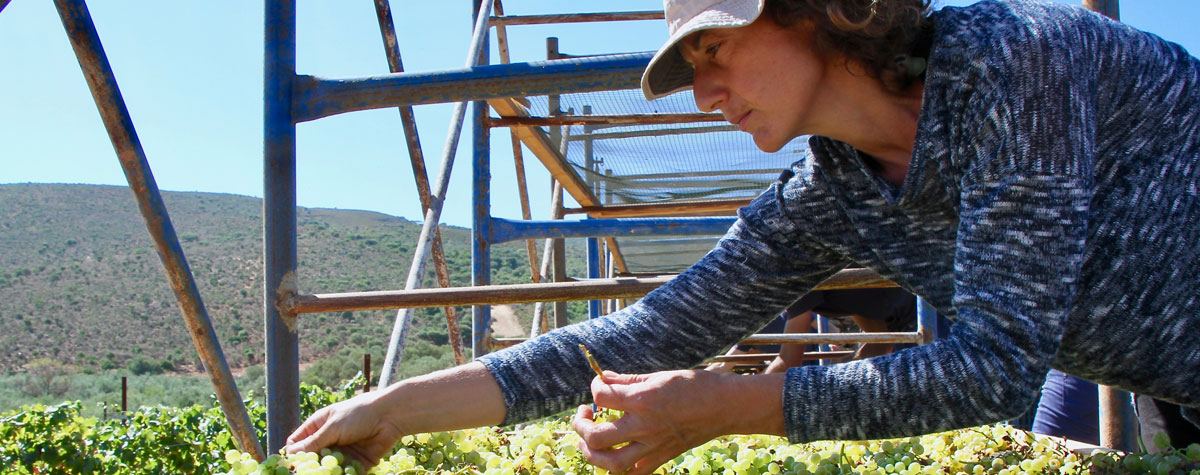







.png)



